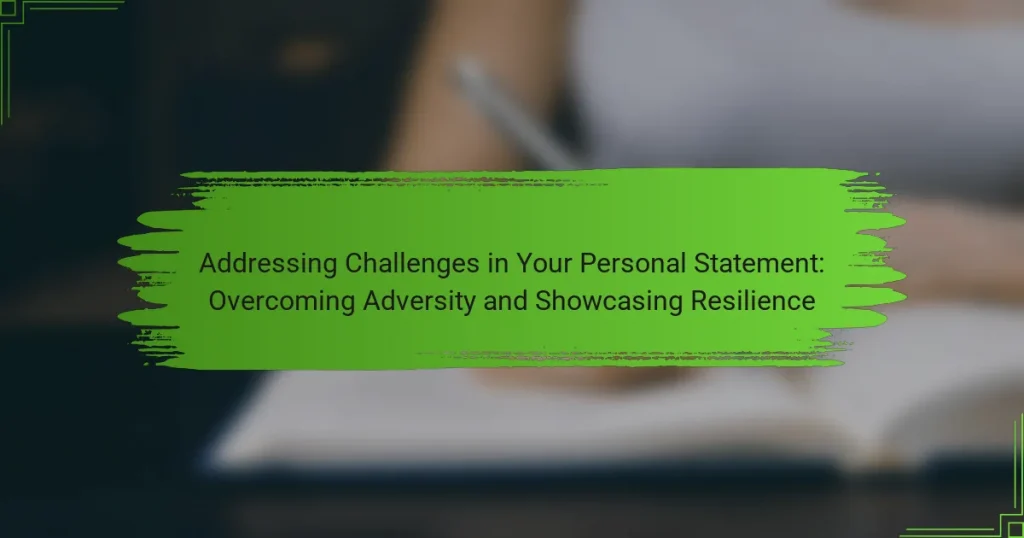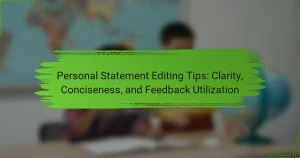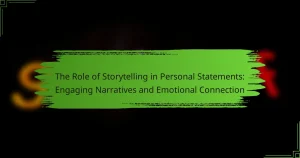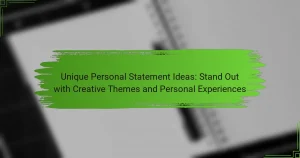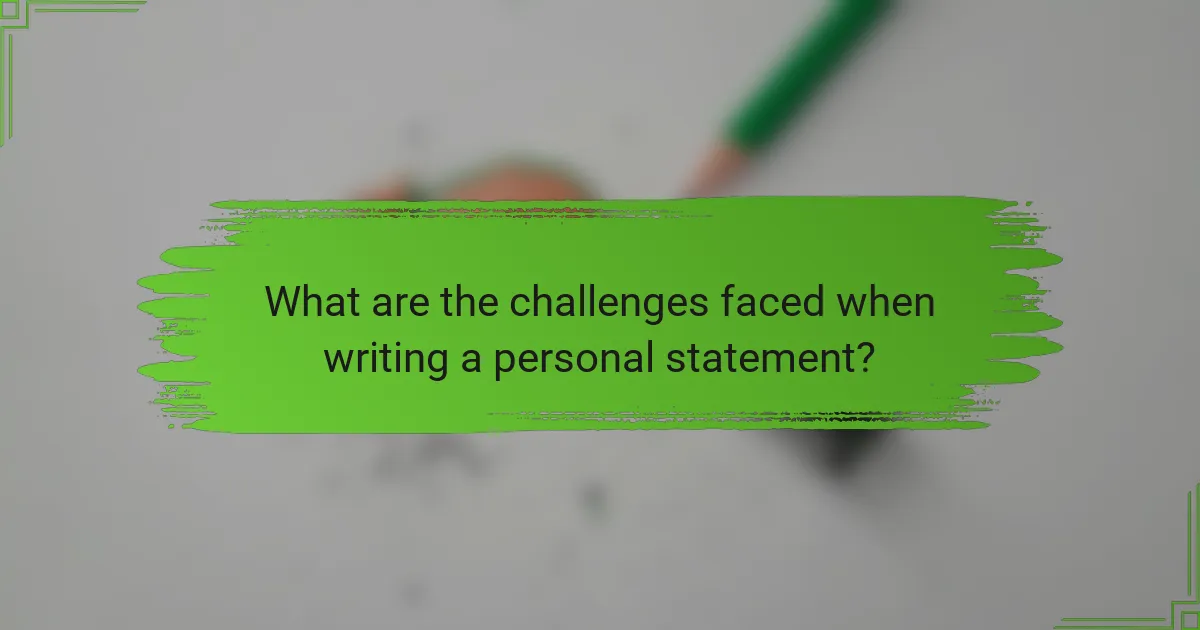
What are the challenges faced when writing a personal statement?
Writing a personal statement presents several challenges. One major challenge is articulating personal experiences effectively. Many individuals struggle to convey their stories in a compelling manner. Another challenge is maintaining a balance between professionalism and personal touch. This balance is crucial for engaging the reader while remaining appropriate. Additionally, individuals often face difficulties in adhering to word limits. This constraint can limit expression and lead to omitted important details. Furthermore, differentiating oneself from other applicants can be daunting. Many candidates share similar backgrounds and accomplishments. Finally, self-doubt frequently hampers the writing process. This can lead to procrastination or incomplete submissions.
How can adversity be effectively addressed in a personal statement?
Adversity can be effectively addressed in a personal statement by clearly articulating the challenge faced. Start by describing the specific adversity in a concise manner. Follow this with an explanation of the actions taken to overcome the challenge. Highlight personal growth and lessons learned from the experience. Use concrete examples to illustrate resilience. Emphasize how the adversity shaped your character and future aspirations. This approach allows admissions committees to understand your perseverance. It demonstrates your ability to navigate difficulties, which is a valuable trait in any candidate.
What types of adversity can be discussed in a personal statement?
Types of adversity that can be discussed in a personal statement include personal struggles, family issues, health challenges, and socioeconomic difficulties. Personal struggles may involve mental health issues, trauma, or self-doubt. Family issues could encompass divorce, loss of a loved one, or caregiving responsibilities. Health challenges might include chronic illness or disability that impacted education or life experiences. Socioeconomic difficulties often relate to financial hardships, lack of access to resources, or educational inequities. Each type of adversity can illustrate resilience and growth, showcasing the ability to overcome obstacles.
How can personal experiences of adversity enhance the narrative?
Personal experiences of adversity can significantly enhance a narrative by adding depth and authenticity. They provide a unique perspective that resonates with audiences. Adversity often leads to personal growth, showcasing resilience and determination. This growth can be illustrated through specific examples and challenges faced. For instance, overcoming hardship can demonstrate problem-solving skills and adaptability. Studies show that narratives featuring personal challenges can increase relatability and emotional engagement. According to research by Pennebaker and Chung, sharing personal struggles can foster connection and understanding. Thus, integrating adversity into a narrative enriches the storytelling experience.
Why is showcasing resilience important in a personal statement?
Showcasing resilience in a personal statement is important because it demonstrates an individual’s ability to overcome challenges. Resilience reflects personal strength and adaptability in difficult situations. Admissions committees value candidates who can navigate adversity and maintain focus on their goals. Highlighting resilience can differentiate an applicant in a competitive field. It illustrates problem-solving skills and a proactive mindset. Research indicates that resilience is linked to success in academic and professional settings. For instance, a study by the American Psychological Association found that resilient individuals are more likely to achieve their objectives despite setbacks. This evidence supports the significance of resilience in personal narratives.
What qualities define resilience in the context of personal statements?
Resilience in personal statements is defined by qualities such as perseverance, adaptability, and emotional strength. Perseverance showcases the ability to continue striving despite challenges. Adaptability highlights the capacity to adjust to changing circumstances. Emotional strength reflects the ability to maintain a positive outlook in adversity. These qualities collectively illustrate a person’s capability to overcome obstacles. Demonstrating these traits can enhance the impact of a personal statement. Specific examples of overcoming difficulties can provide concrete evidence of resilience. Such narratives resonate with readers and effectively convey personal growth.
How can resilience be demonstrated through specific examples?
Resilience can be demonstrated through specific examples such as overcoming personal loss, adapting to significant life changes, and achieving goals despite setbacks. For instance, an individual who faced the death of a loved one may channel their grief into community service, helping others cope with similar losses. Another example is a student who struggled academically but sought tutoring and improved their grades through persistent effort. Additionally, athletes often showcase resilience by returning to their sport after serious injuries, exemplifying determination and commitment. These instances highlight the ability to bounce back and grow stronger despite adversity.
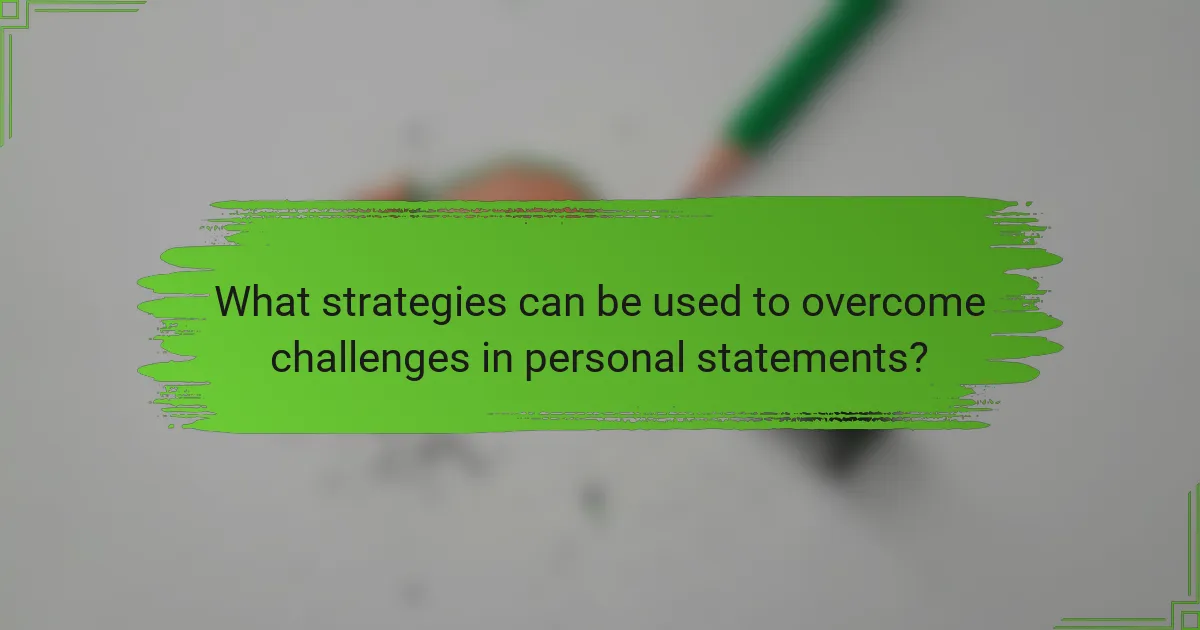
What strategies can be used to overcome challenges in personal statements?
Identify specific challenges faced in writing personal statements. Common challenges include writer’s block, lack of clarity, and difficulty articulating experiences. Develop a clear outline to organize thoughts effectively. This structure aids in maintaining focus and coherence. Seek feedback from peers or mentors to gain insights and improve clarity. Their perspectives can highlight strengths and weaknesses in the statement. Practice writing regularly to enhance confidence and fluency. This approach builds familiarity with the writing process. Use personal anecdotes to illustrate resilience and growth. Real-life examples resonate with readers and create a compelling narrative. Finally, revise multiple drafts to refine the content. This iterative process ensures clarity and effectiveness in communication.
How can one structure their personal statement to highlight challenges and resilience?
Begin with a clear introduction that outlines the challenge faced. Describe the specific adversity in detail. Explain the emotions and thoughts experienced during that time. Share the actions taken to overcome the challenge. Highlight any support received from others. Conclude with the positive outcomes or lessons learned. This structure effectively showcases resilience. Personal statements that follow this format often resonate more with readers. They provide a compelling narrative of growth and determination.
What are effective opening techniques for introducing adversity?
Effective opening techniques for introducing adversity include using a personal anecdote, presenting a startling statistic, or posing a thought-provoking question. Personal anecdotes create an emotional connection with the reader. For example, sharing a specific moment of struggle can illustrate resilience. Startling statistics can capture attention and highlight the significance of the issue. For instance, stating that “over 70% of individuals face significant challenges in their lives” can set the context for discussing adversity. Posing a thought-provoking question engages the reader’s curiosity. Asking, “Have you ever faced a challenge that changed your perspective?” encourages reflection on personal experiences. These techniques effectively draw readers into the narrative of overcoming adversity.
How can transitions between challenges and resilience be managed?
Transitions between challenges and resilience can be managed through structured coping strategies. These strategies include identifying specific challenges and assessing personal strengths. Acknowledging emotions during challenging times promotes emotional regulation. Setting realistic goals helps in navigating adversity effectively. Seeking support from peers or mentors enhances resilience. Practicing mindfulness techniques can improve focus and reduce stress. Research indicates that resilience can be developed through consistent practice and reflection. This approach fosters a positive mindset, enabling smoother transitions between challenges and resilience.
What common pitfalls should be avoided when discussing challenges?
Common pitfalls to avoid when discussing challenges include focusing too much on negativity. Highlighting only the difficulties can create a pessimistic tone. It’s essential to balance challenges with lessons learned and growth achieved. Avoid vague descriptions of challenges without specific examples. Specificity adds credibility and relatability. Another pitfall is failing to connect challenges to personal development. Admissions committees look for resilience and transformation. Overemphasizing external factors can also detract from personal accountability. Taking ownership of one’s journey shows maturity. Lastly, avoid using jargon or overly complex language. Clarity enhances understanding and engagement.
How can negative experiences be framed positively?
Negative experiences can be framed positively by emphasizing personal growth and lessons learned. This reframing highlights resilience and adaptability. For instance, overcoming a challenge showcases determination. It can illustrate how setbacks led to new opportunities. Sharing specific examples enhances credibility. Research shows that individuals who reframe adversity report higher well-being. A study by Tugade and Fredrickson found that positive reappraisal contributes to emotional resilience. By focusing on the positive outcomes of negative experiences, one can effectively demonstrate strength in personal statements.
What should be avoided to maintain authenticity and sincerity?
To maintain authenticity and sincerity, avoid exaggerating personal experiences. Overstating challenges can lead to mistrust. Authenticity requires truthful representation of your journey. Avoid using clichés that dilute personal meaning. Generic statements can make your narrative less impactful. Additionally, steer clear of comparing your struggles to others’ experiences. This can undermine your unique perspective. It is essential to focus on personal insights gained from adversity. Avoiding these pitfalls helps ensure a genuine connection with your audience.
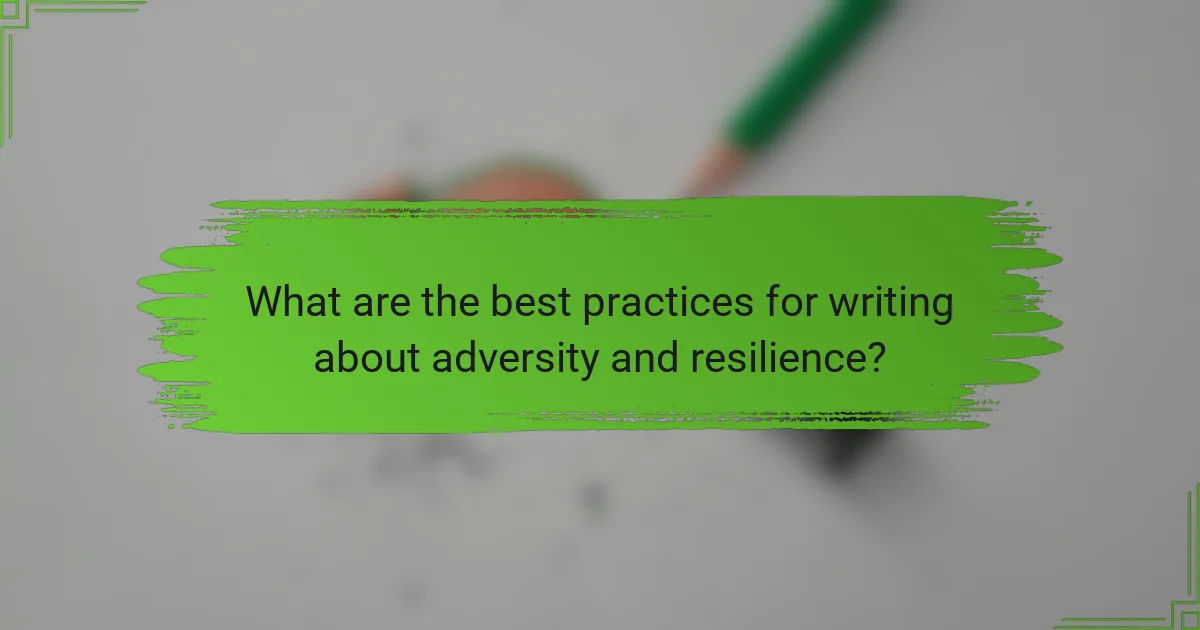
What are the best practices for writing about adversity and resilience?
Best practices for writing about adversity and resilience include being honest and reflective. Authenticity resonates with readers. Use specific examples to illustrate challenges faced. Describe the emotions experienced during these challenges. Highlight the actions taken to overcome adversity. Show the lessons learned and how they contributed to personal growth. Maintain a positive tone that emphasizes resilience. Tailor the narrative to connect with the audience’s experiences.
How can feedback improve the effectiveness of a personal statement?
Feedback enhances the effectiveness of a personal statement by providing external perspectives. It identifies areas for improvement that the writer may overlook. Constructive criticism can clarify the statement’s message. Feedback helps refine language and structure for better readability. It also ensures that the personal statement aligns with the intended audience’s expectations. Peer reviews can reveal emotional impact and authenticity. Studies show that feedback can increase the overall quality of written work significantly. For instance, research by Graham and Perin (2007) indicates that feedback improves writing skills and clarity.
What role does peer review play in refining personal statements?
Peer review significantly enhances the quality of personal statements. It provides critical feedback from peers who can identify strengths and weaknesses. This external perspective helps in clarifying ideas and improving coherence. Additionally, peer reviewers can suggest alternative phrasing and structure. Their insights often lead to a more polished and compelling narrative. Research indicates that collaborative editing improves writing outcomes. For example, studies show that peer feedback increases clarity and engagement in personal statements. Thus, incorporating peer review is essential for refining personal statements effectively.
How can one incorporate constructive criticism effectively?
Incorporating constructive criticism effectively involves actively listening to feedback. This means paying close attention to what is being said without becoming defensive. Next, one should reflect on the feedback to understand its context and implications. This reflection allows for identifying specific areas for improvement. Implementing the feedback requires setting actionable goals based on the insights received. Additionally, seeking clarification on any unclear points can enhance understanding. Lastly, demonstrating progress by applying the feedback can lead to personal growth and resilience. Research shows that individuals who embrace constructive criticism tend to improve their performance and adaptability (Hattie & Timperley, 2007).
What tips can enhance the overall impact of a personal statement?
To enhance the overall impact of a personal statement, focus on clear and concise storytelling. Begin with a compelling introduction that captures attention immediately. Use specific examples to illustrate personal challenges and resilience. This approach demonstrates authenticity and vulnerability. Maintain a consistent tone and voice throughout the statement. Tailor the content to reflect the values and mission of the institution or program. Edit rigorously to eliminate grammatical errors and improve clarity. Seek feedback from peers or mentors to gain different perspectives. These strategies collectively strengthen the effectiveness of a personal statement.
How can storytelling techniques be applied to personal statements?
Storytelling techniques can enhance personal statements by creating a compelling narrative. Personal statements should include a clear structure with a beginning, middle, and end. The beginning should introduce the main theme or challenge faced by the individual. The middle should describe the journey, detailing obstacles and how they were overcome. The end should reflect on the lessons learned and personal growth achieved. Engaging anecdotes can make the narrative relatable and memorable. Using vivid imagery helps to paint a picture in the reader’s mind. Incorporating emotions allows readers to connect on a personal level. Overall, storytelling makes personal statements more impactful and authentic.
What are the key elements to include for a compelling conclusion?
A compelling conclusion should summarize key points, reinforce the main message, and leave a lasting impression. Summarizing key points helps to remind the reader of the core arguments presented. Reinforcing the main message ensures that the reader understands the significance of the discussed challenges and resilience. Leaving a lasting impression can be achieved by ending with a thought-provoking statement or a call to action. This structure strengthens the overall impact of the personal statement.
The main entity of this article is the personal statement, specifically focusing on the challenges faced in writing it, such as articulating personal experiences, maintaining professionalism, and adhering to word limits. The article outlines strategies for addressing adversity within personal statements, emphasizing the importance of showcasing resilience through specific examples of personal growth and overcoming obstacles. It also discusses effective techniques for structuring personal statements, avoiding common pitfalls, and utilizing feedback to enhance clarity and impact. Overall, the content provides comprehensive guidance on how to effectively convey challenges and resilience in personal narratives.
